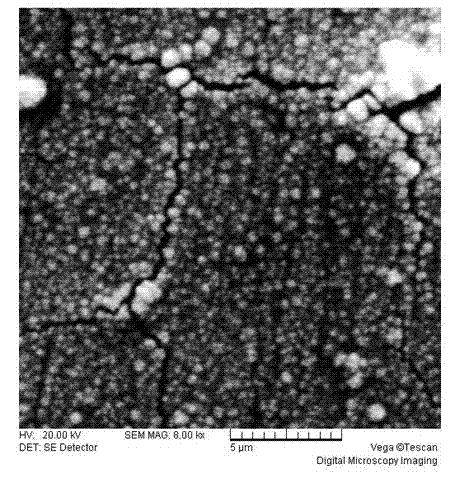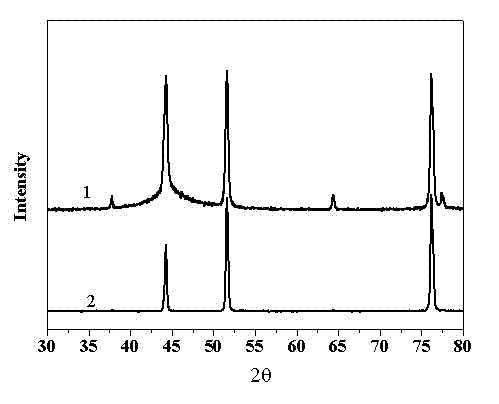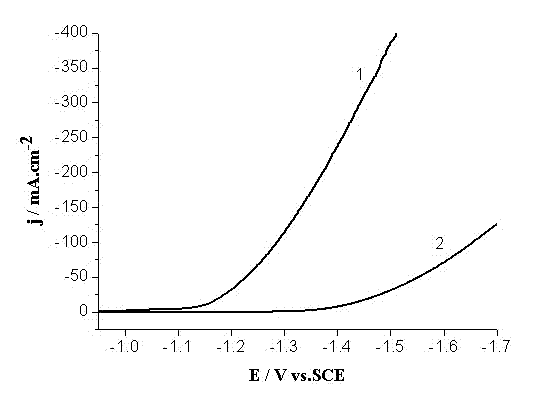Preparation method of efficient Ni-Mo-P/Ni hydrogen evolution electrode
A hydrogen evolution electrode, ni-mo-p technology, applied in the field of electrocatalytic hydrogen evolution, can solve the problem of high electronegativity of rare earth elements, achieve the effect of large specific surface area, unique amorphous structure, and small internal stress
- Summary
- Abstract
- Description
- Claims
- Application Information
AI Technical Summary
Problems solved by technology
Method used
Image
Examples
Embodiment 1
[0029] (1) Pretreatment of Ni substrate
[0030] First, mechanically polish the Ni sheet to remove oxides on the surface to make it metallic luster, and then clean it with ultrapure water; It is a mixed aqueous solution of 45g / L sodium sulfate, 45g / L sodium carbonate and 45g / L sodium chloride; then rinse it with deionized water, dry it naturally and immerse it in absolute ethanol solution for use;
[0031] (2) Preparation of Ni-Mo-P / Ni electrode by pulse electrodeposition
[0032] A two-electrode system is adopted, the Ni substrate treated in step (1) is used as the working electrode, and the Ni plate is used as the counter electrode. The composition of Ni-Mo-P plating solution is: 40g / L nickel sulfate aqueous solution, 30 g / L sodium molybdate aqueous solution, 10 g / L sodium hypophosphite aqueous solution, 150 g / L trisodium citrate aqueous solution, 200 g / L L sodium chloride aqueous solution, the pH value of the plating solution is 8, and the temperature of the plating solut...
Embodiment 2
[0035] Step (1) is the same as step (1) in Example 1;
[0036] (2) Preparation of Ni-Mo-P / Ni electrode by pulse electrodeposition
[0037] A two-electrode system is adopted, the Ni substrate treated in step (1) is used as the working electrode, and the Ni plate is used as the counter electrode. The composition of Ni-Mo-P plating solution is: 20g / L nickel nitrate aqueous solution, 50 g / L sodium molybdate aqueous solution, 60 g / L sodium hypophosphite aqueous solution, 150 g / L trisodium citrate aqueous solution, 10 g / L L sodium chloride aqueous solution, the pH value of the plating solution is 10, and the temperature of the plating solution is 60°C. The pulse peak current density is 30A / dm2 , the pulse on time is 0.1ms, the pulse off time is 0.5ms, and the electrodeposition time is 5s. Rinse with deionized water after electroplating to remove residual plating solution, and make Ni-Mo-P electrode after natural air drying.
[0038] Prepared Ni-Mo-P / Ni plated electrode and pure n...
Embodiment 3
[0040] Step (1) is the same as step (1) in Example 1;
[0041] (2) Preparation of Ni-Mo-P / Ni electrode by pulse electrodeposition
[0042] A two-electrode system is adopted, the Ni substrate treated in step (1) is used as the working electrode, and the Ni plate is used as the counter electrode. The composition of the Ni-Mo-P plating solution is: 60 g / L nickel chloride aqueous solution, 10 g / L ammonium molybdate aqueous solution, 30 g / L sodium hypophosphite aqueous solution, 20 g / L trisodium citrate aqueous solution, 300 g / L sodium chloride aqueous solution, the pH value of the plating solution is 1, and the temperature of the plating solution is 40°C. Pulse peak current density is 10A / dm 2 , the pulse on time is 10ms, the pulse off time is 50ms, and the electrodeposition time is 300s. Rinse with deionized water after electroplating to remove residual plating solution, and make Ni-Mo-P electrode after natural air drying;
[0043] (3), Ni-Mo-P / Ni coating hydrogen evolution p...
PUM
 Login to View More
Login to View More Abstract
Description
Claims
Application Information
 Login to View More
Login to View More - R&D
- Intellectual Property
- Life Sciences
- Materials
- Tech Scout
- Unparalleled Data Quality
- Higher Quality Content
- 60% Fewer Hallucinations
Browse by: Latest US Patents, China's latest patents, Technical Efficacy Thesaurus, Application Domain, Technology Topic, Popular Technical Reports.
© 2025 PatSnap. All rights reserved.Legal|Privacy policy|Modern Slavery Act Transparency Statement|Sitemap|About US| Contact US: help@patsnap.com



